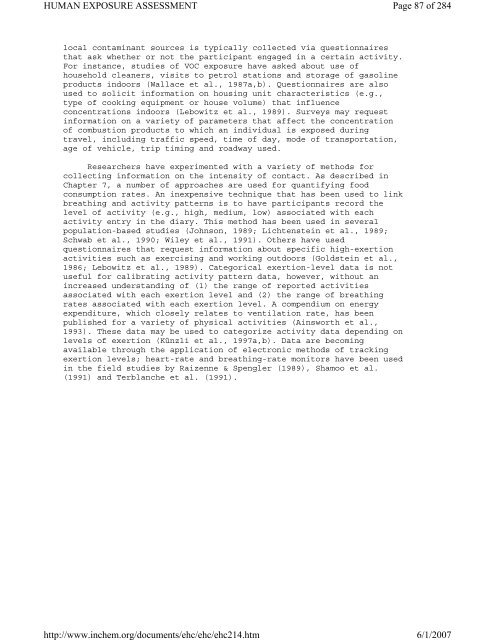Environmental Health Criteria 214
Environmental Health Criteria 214
Environmental Health Criteria 214
Create successful ePaper yourself
Turn your PDF publications into a flip-book with our unique Google optimized e-Paper software.
HUMAN EXPOSURE ASSESSMENT<br />
local contaminant sources is typically collected via questionnaires<br />
that ask whether or not the participant engaged in a certain activity.<br />
For instance, studies of VOC exposure have asked about use of<br />
household cleaners, visits to petrol stations and storage of gasoline<br />
products indoors (Wallace et al., 1987a,b). Questionnaires are also<br />
used to solicit information on housing unit characteristics (e.g.,<br />
type of cooking equipment or house volume) that influence<br />
concentrations indoors (Lebowitz et al., 1989). Surveys may request<br />
information on a variety of parameters that affect the concentration<br />
of combustion products to which an individual is exposed during<br />
travel, including traffic speed, time of day, mode of transportation,<br />
age of vehicle, trip timing and roadway used.<br />
Researchers have experimented with a variety of methods for<br />
collecting information on the intensity of contact. As described in<br />
Chapter 7, a number of approaches are used for quantifying food<br />
consumption rates. An inexpensive technique that has been used to link<br />
breathing and activity patterns is to have participants record the<br />
level of activity (e.g., high, medium, low) associated with each<br />
activity entry in the diary. This method has been used in several<br />
population-based studies (Johnson, 1989; Lichtenstein et al., 1989;<br />
Schwab et al., 1990; Wiley et al., 1991). Others have used<br />
questionnaires that request information about specific high-exertion<br />
activities such as exercising and working outdoors (Goldstein et al.,<br />
1986; Lebowitz et al., 1989). Categorical exertion-level data is not<br />
useful for calibrating activity pattern data, however, without an<br />
increased understanding of (1) the range of reported activities<br />
associated with each exertion level and (2) the range of breathing<br />
rates associated with each exertion level. A compendium on energy<br />
expenditure, which closely relates to ventilation rate, has been<br />
published for a variety of physical activities (Ainsworth et al.,<br />
1993). These data may be used to categorize activity data depending on<br />
levels of exertion (Künzli et al., 1997a,b). Data are becoming<br />
available through the application of electronic methods of tracking<br />
exertion levels; heart-rate and breathing-rate monitors have been used<br />
in the field studies by Raizenne & Spengler (1989), Shamoo et al.<br />
(1991) and Terblanche et al. (1991).<br />
http://www.inchem.org/documents/ehc/ehc/ehc<strong>214</strong>.htm<br />
Page 87 of 284<br />
6/1/2007

















